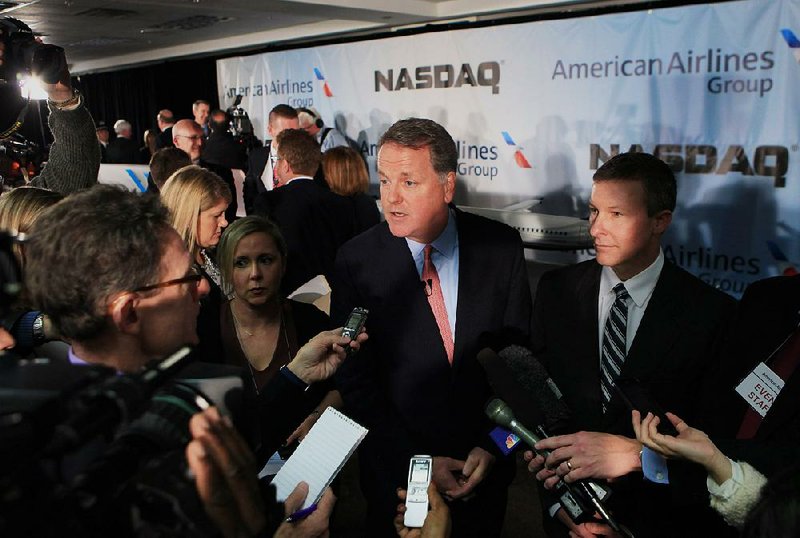FORT WORTH - US Airways and American Airlines closed their merger Monday, creating American Airlines Group Inc., the world’s largest airline.
The new airline, a combination of the nation’s No. 3and No. 5 carriers, has more than 100,000 employees worldwide that offers nearly 6,500 daily flights to more than 330 destinations in more than 50 countries.
It’s the latest in a series of mergers that will leave four airlines controlling more than 80 percent of the U.S. air-travel market.
Doug Parker, the new airline’s chief executive officer, remotely rang the opening bell of the Nasdaq Stock Market on Monday morning, flanked on a stage in Fort Worth by executives and labor leaders of both airlines and in front of a crowd of cheering employees.
“Our goal here is to go and restore American Airlines to its position as the greatest airline in the world,” Parker said. The largest airline as recently as 2008, American struggled through a decade of losses and fell behind United and Delta in size.
“We all acknowledge we’re not the greatest company in the world now,” Parker said after the festivities. “We’re not where we want to be. The company just emerged from bankruptcy. But we have the right people in place and a platform to get it done.”
For passengers, the merger won’t mean many immediate changes. Whether the deal leads to higher ticket prices, the issue at the heart of legal challenges from the government and consumer groups, remains to be seen.
Parker dismissed the notion that fewer airlines will lead to higher airfares because, he said, the new American plans to keep all the service currently offered by American and US Airways.
“Airline prices are like prices in other businesses - they track with supply and demand, and we’re not reducing any of the supply,” he said in an interview with The Associated Press.
Elite members of the two frequent-flier programs will get reciprocal benefits in early January, with other changes being phased in, executives said. The airlines expect to soon be able to book passengers on each other’s flights, increasing the destinations available to customers of both.
“They are in a good position,” said Savanthi Syth, a Raymond James Financial Inc. analyst. “That’s not to say they won’t have any hiccups, but they have their own merger experience and they’ve watched what’s worked and hasn’t worked for others. They will be a formidable competitor.”
Investors appeared to be encouraged by the deal. American Airlines shares rose 65 cents, or 2.7 percent, to close Monday at $24.60.
It will take about two years to combine American’s fleet and workforce with those of US Airways, Parker said. US Airways will join Continental, Northwest and other airlines that now exist only in the memories of employees and longtime travelers.
Airline mergers are notoriously troublesome. United has been plagued by computer-network problems since combining with Continental, leading to system failures and flight delays. Airlines’ technology systems handle everything from passenger information to weight and balance calculations on every flight. Then there is the difficulty in merging two sets of employees who, in this case, are represented by different unions. US Airways has been down that path before - it still hasn’t fully integrated pilot crews since its merger with America West, and that deal closed in 2005.
Unions at American gave Parker a warm welcome. Their support for a merger led by US Airways executives was a turning point when AMR CEO Tom Horton still hoped to keep his airline independent. For their efforts, the unions won stock in the new company.
On Monday, Parker made symbolic moves to extend a hand to labor - painting over parking spaces once reserved for executives, and asking Nasdaq to inscribe a commemorative opening bell to the employees instead of to him. Still, the honeymoon could be a short one.
“His greatest challenge is keeping positive sentiment on his side,” said Vicki Bryan, an analyst with bond-research firm Gimme Credit. “He’s at the peak of ‘happy’ right now. He’s got to keep the unions happy; he’s got to keep the computers running; he’s got to keep the balloon in the air.”
Being the greatest airline, Parker told workers Monday, means being one where customers want to fly and where people want to work.
“Today’s about celebrating and working,” Parker said. “Tomorrow is all about working.” Information for this article was contributed by David Koenig of The Associated Press, Mary Schlangenstein of Bloomberg News, Andrea Ahles of the Fort Worth Star-Telegram and Ely Portillo of The Charlotte Observer.
Front Section, Pages 1 on 12/10/2013


